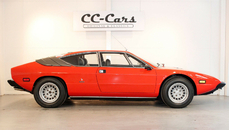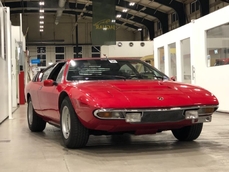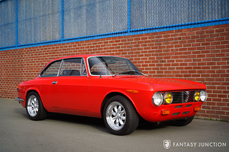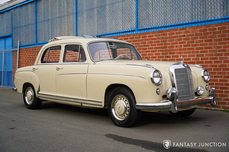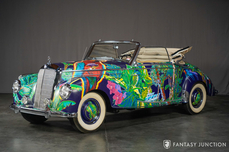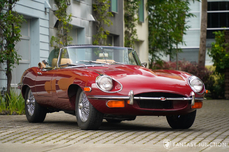Lamborghini Urraco 3.0 Liter Quad Cam V8 no. 20216 1976
Allgemeine Beschreibung :
1976 Lamborghini Urraco P300
s/n 20240, engine no. 20216
Orange with Cognac Leather Interior
The stunning and advanced Lamborghini Urraco debuted at the 1970 Turin Auto Show, and was an exciting new Lamborghini model meant to introduce the marque to a new group of buyers at a more accessible price point. Featuring an all new 2.5 liter V8, it showed a healthy disregard for convention like the Miura before it. Like the Miura, the Urraco was penned by Marcello Gandini, and employed a transversely oriented mid-mounted engine. Additionally, it had four seats, laying the foundation for a format that would be adopted a few years later by Ferrari’s 308 GT4 and its Mondial successor.
The production version of the Urraco arrived in 1973, initially in 2.5 liter form, with a 2.0 liter version introduced for the Italian market to take advantage of the significant difference in taxation rate for engines over 2 liters. The ultimate version of the Urraco was the 3.0 liter P300. Not only did it have an additional half liter of displacement, the cylinder heads employed dual overhead cams instead of single overhead cams. The result was an impressive 247hp, 5.6 second 0-60 time, and 162 mph top end. Suspension and gearbox improvements were also implemented, as was improved cooling thanks to a 6 louvered front decklid, and the headlights were relocated to improve night visibility. Compared to more than 500 P250s, just 190 P300s were built, making them exceptionally rare and desirable. Certainly they are significantly improved cars and incorporate the performance and functionality that make them among the highest performance cars of the 1970s.
This particular P300 was completed at Lamborghini’s Sant’Agata Bolognese factory on May 14, 1976, making it among the last of the Urracos built before production ceased. Since P300 Urracos were never officially imported to the United States, this car arrived in North America later in its life, where it appears to have been very well cared for, including extensive services under current ownership. For approximately 10-12 years, this car was stored in Berkeley, California and driven occasionally by its New York-based owner when he was in town. Fantasy Junction sold the car to its current owner in early 2015 and he set about significantly improving the car, spending over $33,000 since then, primarily on mechanical improvements.
Detailed invoices at European Autowerke in Fall City, CA include removing the engine and gearbox, refinishing the sub-frame, new transmission and engine mounts, a new clutch and flywheel, new starter, clutch kit, main shaft seal, drive shaft gaskets, new CV joint boots, new brake cable, handbrake boot, new exhaust manifold gaskets, new shock snubbers, bellows, and buffers, and new rear axle bearings. While the sub-frame and engine were out, all parts were properly refinished using black oxide powder coating and zinc plating. The engine compartment was detailed and the engine reinstalled using proper fasteners and hardware wherever possible. Additional work in 2016 included rebuilding the front and rear brake calipers, new accessory engine belts, new cam cover gaskets, a new ignition coil, new spark plugs, a new alternator, and a new voltage regulator. New Michelin XWX tires were also fitted during this period.
The car presents very nicely in stunning colors. Painted a vivid and correct bright orange, the finish is very well done overall exhibiting high gloss throughout, excellent coverage, with only minor small chips from road use and a few other minor flaws. The color of paint on the front decklid slightly mismatches the paint on the front clip. Trim and plating are of very good quality overall, both on the chrome and black finished components. The glass and various rubber parts throughout the exterior are in very good condition. The front windscreen was recently replaced. The beautiful and definitive Urraco satin black louvers are very nicely finished with excellent, even gapping at the rear, sides, and in the six front vents (unique only to the P300). The doors, engine lid, and trunk open and shut easily, showing excellent fit around the perimeter of all these openings including the headlight doors. The gap on the trailing edge of the front deck light is a bit tight.
The interior appears to be original, and is in impressive condition considering this. The car has been properly stored indoors, preserving an excellent original dash pad, wonderful dished steering wheel, and a nicely trimmed center console with just minor evidence of aging. The contrasting black dash and details enhance the cognac seats and door panels, which remain impressively supple. The carpet appears to be original and generally in very good condition. The original instrumentation and switches are all in excellent condition mounted against a nice brushed aluminum dash panel, with bright dials displaying excellent color. The black toggle switches are all in very good condition. The look and feel of the dash is very futuristic and sophisticated, with a marvelously retro futuristic execution and layout, from the italicized H shift pattern to the unusual placement of the speedometer and tachometer to the incredibly cool steering wheel. The seats are in excellent condition with good foam padding and nice upholstery which exhibits some minor surface wear to the bolsters and a few light scratches, but is impressively nice overall. The leather finishes overall are smooth and uniform, and stitching is also nicely preserved. Door panels are clean, correctly padded, and taut with excellent overall fit and finish. The trunk is finished with red carpeting while the front space is finished with a full size spare tire and easy access to the battery and other mechanical components.
The engine compartment has been properly finished and detailed during the 2016 service. The engine appears to have correctly restored components and details befitting a car of this period. Clean and tidy throughout, the quad cam covers and various other cast engine parts are all beautifully composed against the correctly finished textured black painted features. The undercarriage is very nice overall with a few scuffs and marks from normal use, having never been restored, while the rear mechanical components have a crisp, recently restored appearance following the recent engine-out service.
The car starts easily and runs smoothly, with a wonderful almost American V8 engine sound which is very different from that of a Ferrari 308. The carburetion and other running characteristics are excellent, having been tuned up when the engine was out for service in late 2016. Acceleration is quick off the line with smooth clutch engagement and excellent gearbox action. Shift effort is low and synchromesh effectiveness is impressively good, particularly compared against contemporary Ferraris. The steering effort is remarkably light, despite the relatively small diameter steering wheel and the car is a pleasure to drive and easy to place on the road at all speeds. The ride quality is very good thanks to the ample sidewalls of the Michelin XWXs. Braking is effective, linear, and responsive in nature, as is the behavior from the chassis. There is a pleasing coherence to the way this car operates that gives the driver a sense of satisfaction and confidence. The car comes with extensive records from the current ownership period showing the many thousands of dollars that went into properly sorting the car. Also included is the original owner’s manual (specific to the P300).
This is an exceptionally rare opportunity to acquire a wonderfully sorted and unmolested quad cam 3.0 liter Urraco. These cars come to market so infrequently that the buyer seeking a Urraco must often compromise: on displacement, color, cosmetic condition, mechanical soundness, or on all of these aspects. This particular car however, is the right model in the right color in the right undisturbed but mechanically sorted state that makes it absolutely the ideal example for the enthusiast or collector seeking a wonderfully unique and thoroughly Italian expression of mid-engine performance motoring.
http://fantasyjunction.com/cars/1608-Lamborghini-Urraco%20P300-3.0%20Liter%20Quad%20Cam%20V8
1976 Lamborghini Urraco 3.0 Liter Quad Cam V8 no. 20216 is listed verkauft on ClassicDigest in Emeryville by Fantasy Junction for $119500.
Fakten der Auto
Karosserietyp : Auto Marke : Lamborghini Modell : Urraco Ausführung : 3.0 Liter Quad Cam V8 no. 20216 Hubraum : 3.0 Modelljahr : 1976 Lage : Emeryville
Verkauft
Angaben Zum Verkäufer
Verkauft
People who viewed this Lamborghini Urraco also viewed similar Lamborghini listed at ClassicDigest
Other cars listed for sale by this dealer
über Lamborghini
Ah, die feurige Geschichte von Lamborghini, einem wahren Symbol, geboren aus den Funken der Frustration mit dem springenden Pferd! Stell dir vor, es ist Anfang der 1960er Jahre, eine Zeit, in der die Automobilwelt von Größen wie Ferrari dominiert wird. Und dann betritt Ferruccio Lamborghini die Bühne, ein erfolgreicher Traktorhersteller und Mann mit einer Leidenschaft für kraftvolle Maschinen.Akt 1: Die Frustration (1963)
Ferruccio, stolzer Besitzer mehrerer Ferraris, fand sich unzufrieden mit der Kupplung seines 250 GT. Frustration trieb ihn direkt ins Büro von Enzo Ferrari, um seine Beschwerden vorzubringen. Das Treffen lief nicht wie geplant, mit Enzo, der Ferruccios Bedenken abtat und ihm riet, sich auf Traktoren zu konzentrieren. Nun, das war, als würde man einem Stier einen roten Lappen vor die Nase halten.
Akt 2: Die Geburt von Lamborghini (1963)
Angetrieben von einer Mischung aus Frustration und Entschlossenheit beschloss Ferruccio, die Dinge selbst in die Hand zu nehmen. 1963 gründete er Automobili Lamborghini. Seine Vision? Grand Touring-Autos zu schaffen, die den Angeboten von Ferrari ebenbürtig oder sie sogar übertreffen.
Akt 3: Die Wegweisenden Modelle (1960er-1970er Jahre)
Und so begann die Legende von Lamborghini mit der Veröffentlichung des Miura im Jahr 1966. Entworfen von Marcello Gandini, war dieses mittelmotorische Meisterwerk ein Wegbereiter, der erste echte Supersportwagen der Welt. Mit einem V12-Motor hinter dem Fahrer setzte der Miura Maßstäbe für Leistung und Stil.
Nach dem Erfolg des Miura führte Lamborghini Anfang der 70er Jahre den ikonischen Countach ein. Marcello Gandini zauberte erneut und brachte ein keilförmiges Wunder hervor, das zum Posterkind einer Generation wurde. Der Countach war nicht nur ein Auto; er war eine automobile Revolution.
Akt 4: Die Design-Maestros
Hinter den Kulissen spielten Designer wie Marcello Gandini und später Giugiaro entscheidende Rollen bei der Gestaltung des unverwechselbaren Aussehens von Lamborghini. Gandinis Arbeit am Miura und Countach festigte Lamborghinis Ruf für kühne, kantige Designs, die die Grenzen des Automobildesigns ausloteten.
Akt 5: Das Erbe und Moderne Wunder
Im Laufe der Jahrzehnte setzte Lamborghini die Innovation fort und produzierte ikonische Modelle. Der Diablo, Murciélago, Aventador und die neueren Huracán und Urus tragen alle das Lamborghini-DNA – eine perfekte Mischung aus Leistung, Performance und unverkennbarem Design.
Epilog: Eine Heftige Rivalität
Die Lamborghini-Ferrari-Rivalität wurde legendär und trieb beide Unternehmen an, die Grenzen der Automobiltechnik zu erweitern. Lamborghini, aus Frustration geboren, erwies sich nicht nur als Konkurrent, sondern auch als Wegbereiter, der den Weg für mittelmotorische Supersportwagen ebnete, die Enthusiasten weltweit weiterhin faszinieren.
Da hast du es also, die epische Saga von Lamborghini – eine Geschichte von Frustration, die sich in eine Symphonie von röhrenden Motoren, eleganten Designs und einem Erbe verwandelte, das die Landschaft der Hochleistungsautos für immer veränderte.


